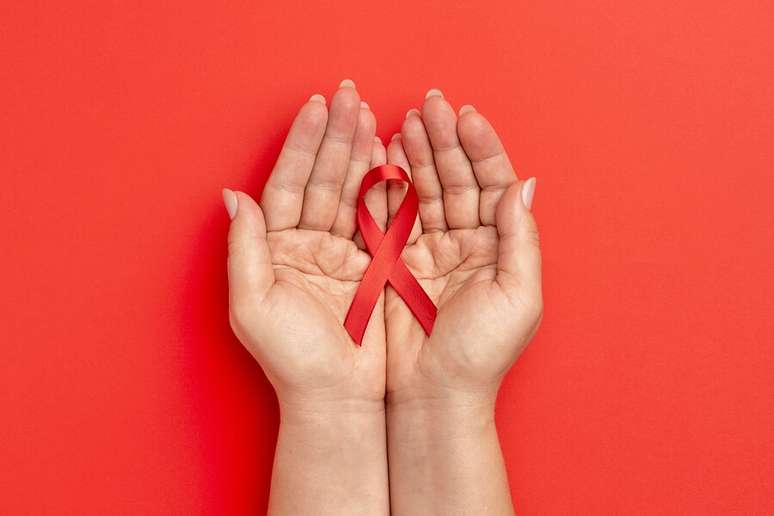The month is dedicated to the care, prevention and support of sick people
Red December symbolizes attention to HIV, an acronym in English for human immunodeficiency virus. In addition to raising public awareness, the campaign also aims to welcome HIV-positive people, a term used to indicate that the person is a carrier of the virus. According to the Ministry of Health, the incidence of new HIV cases is increasing among young people between 20 and 34 years old, which worries health authorities.
“For anyone who was a teenager or adult in the 1980s, this may seem like a flashback, as during that time Brazil had its first case of AIDS, followed by an epidemic of the disease. At that time, the topic was seen in an extremely prejudicial and exclusive way,” says Karina Santos, a doctor at Sami’s Health Team, a health technology that has a model focused on primary healthcare, with a healthcare team and a coordinated assistance.
“More than 40 years later, however, we still encounter many taboos and myths about AIDS and HIV. Therefore, not only now, but every other day of the year, it is essential to talk about the pathology and bring quality information to more and more people, ”he adds.
The action of the virus
HIV is the name given to the virus that causes AIDS, known scientifically as the human immunodeficiency virus. This virus can invade the body through contact with the blood or fluids of an infected person. This is how the individual begins to be considered HIV positive and, even without showing symptoms, can infect other individuals.
AIDS, in turn, is known as acquired immunodeficiency syndrome, diagnosed when the HIV virus multiplies in the body and begins to destroy defense cells. The disease affects the immune system, preventing it from defending the body from invading agents. Therefore, it is common for people with this disease to develop serious complications resulting from relatively simple illnesses, such as the flu and urinary infections.
“Those who carry the virus do not necessarily have AIDS, as it can remain dormant for years without the disease manifesting itself. But for a person to develop AIDS, he must have contracted the HIV virus,” explains the doctor.
Forms of transmission
Even without developing the disease, anyone with HIV can pass it on to other people. This contagion can occur through transfusion of contaminated blood; sexual intercourse without the use of a condom, including vaginal, oral and anal intercourse.
This causes the disease to be classified as a sexually transmitted infection (STI); maternity – if the mother is HIV-positive, she can transmit it to her child during pregnancy, breastfeeding or even during childbirth; sharing unsterilized sharp instruments, such as nail pliers, spatulas or syringes.
There are people who live with the virus for years without showing symptoms, but this does not mean that the virus is eliminated from the body. On the contrary. The disease multiplies silently. In this way, the functioning of the immune system is gradually compromised, leading to the development of AIDS.
At this stage, it is common for the person to have recurring episodes of sore throat, headache, low-grade fever, excessive tiredness, sore tongue, diarrhea and mouth ulcers. As the condition worsens, progressing to the diagnosis of AIDS, the person may experience: frequent high fever; difficulty breathing; wounds in the genital region; spots on the skin; constant cough; weight loss.
“The sooner the detection is done, the better. This is because in the initial phase it is easier to control the virus, as well as prevent its spread,” explains Karina.
How to prevent yourself?
Use of a condom from the beginning of sexual intercourse; post-exposure prophylaxis (PEP): use of antiretroviral drugs after a situation in which there is a risk of contact with the virus. For example: accident with infected blood, loss or breakage of condom, unprotected sexual intercourse or case of sexual violence.
In these cases, treatment should begin as soon as possible. It is most effective if started within 2 hours and a maximum of 72 hours after contact and must be maintained for 28 days. Pre-exposure prophylaxis (PrEP) involves continued use of the drug by people who do not have the virus. It is recommended for people at high risk of contracting the infection.
Prevention of vertical transmission: HIV testing is included in prenatal exams, as adequate treatment prevents the baby from contracting the virus. It is necessary for the child to use drugs even in the first month of life and, in these cases, breastfeeding is contraindicated.
Carrying out the test can also be qualified as prevention if it is considered that, once diagnosed, the person will begin treatment. All HIV treatments, including PrEP and PEP, are offered by SUS.
The immunological window essentially refers to the period between infectious contact with an HIV-positive person and the time it takes for the body to produce the antibodies necessary to fight the infection, to the point that they can be identified in laboratory tests.
“The immunological window for HIV is 30 days. Therefore it is necessary to wait 30 days from the risk situation for the virus to be detected by the test. Paying attention to the deadline is essential to avoid a false negative result,” comments Sami’s doctor.
“There is no way to completely eliminate the virus from the body yet. However, currently, access to tests and drugs to control HIV and treat AIDS allows patients to live long and healthy lives, even with this disease,” concludes Karina.
inspires transformation in the world of work, in business, in society. Compasso, a content and connection agency, is born.
Source: Terra
Ben Stock is a lifestyle journalist and author at Gossipify. He writes about topics such as health, wellness, travel, food and home decor. He provides practical advice and inspiration to improve well-being, keeps readers up to date with latest lifestyle news and trends, known for his engaging writing style, in-depth analysis and unique perspectives.








